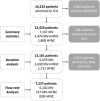Variability of oxygen requirements in critically ill COVID-19 patients
- PMID: 38390629
- PMCID: PMC10884784
- DOI: 10.7189/jogh.14.05012
Variability of oxygen requirements in critically ill COVID-19 patients
Abstract
Background: The global scarcity of medical oxygen has proven to be catastrophic during the surges in COVID-19 cases over the past two years, with the heaviest burden felt in low- and middle-income countries. Despite its criticality, data and analyses of oxygen consumption, even for typical clinical cases, are missing. Consequently, planning oxygen needs, particularly with variable surges in COVID-19 cases, has presented a substantial challenge to policymakers and hospital decision-makers.
Methods: We performed a sub-analysis of the COVID-19 Critical Care Consortium database assessing the oxygen consumption requirements of COVID-19 patients admitted to intensive care units between February 2020 and October 2021. We calculated descriptive statistics for oxygen flow-rates, stratified by oxygen supplementation method, and developed a multi-state model for estimating the frequency, therapy duration, probability of transition, and number of oxygen therapy modes per patient.
Results: Overall, 12 429 patients from 35 countries received oxygen support on at least one day of their hospitalisation. Of the patients with measurable flow rates, 6142 received invasive mechanical ventilation, 838 received high-flow nasal oxygen, and 257 received both modalities. The median flow rate for mechanical ventilation was 3.2 L per minute (interquartile range (IQR) = 2.0-4.9), with a median duration of 12 days (IQR = 6-24), while the median flow rate for high-flow nasal cannula was 40 L per minute (IQR = 15-55), with a median duration of three days (IQR = 2-6).
Conclusions: Oxygen consumption among critical COVID-19 patients varies by mode of delivery (invasive ventilation vs high-flow nasal cannula), across patients, and over treatment duration. Therefore, it is essential that health facilities routinely monitor oxygen utilization to better inform oxygen delivery system design and regular supply planning.
Registration: ClinicalTrials.gov: CTG2021-01 ACTRN12620000421932.
Copyright © 2024 by the Journal of Global Health. All rights reserved.
Conflict of interest statement
Disclosure of interest: The authors completed the ICMJE Disclosure of Interest Form (available upon request from the corresponding author) and disclose no relevant interests.
Figures







References
-
- World Health Organization. Oxygen sources and distribution for COVID-19 treatment centres. Geneva: World Health Organization; 2020. Available: https://www.who.int/publications/i/item/oxygen-sources-and-distribution-.... Accessed: 31 January 2024.
-
- Pratap A, Jennings K. As Covid Cases Surge, India May Need More Than Double The Medical Oxygen It Produces. Forbes. 2021. Available: https://www.forbes.com/sites/katiejennings/2021/05/03/as-covid-cases-sur.... Accessed: 31 January 2024.
-
- Navin SK. African Covid patients 'dying from lack of oxygen'. BBC. 2021. Available: https://www.bbc.com/news/world-africa-57501127. Accessed: 31 January 2024.
-
- Paun C. The worldwide scramble to prevent the next oxygen shortage. Politico. 2021. Available: https://www.politico.com/newsletters/global-pulse/2021/06/03/the-worldwi.... Accessed: 31 January 2024.
